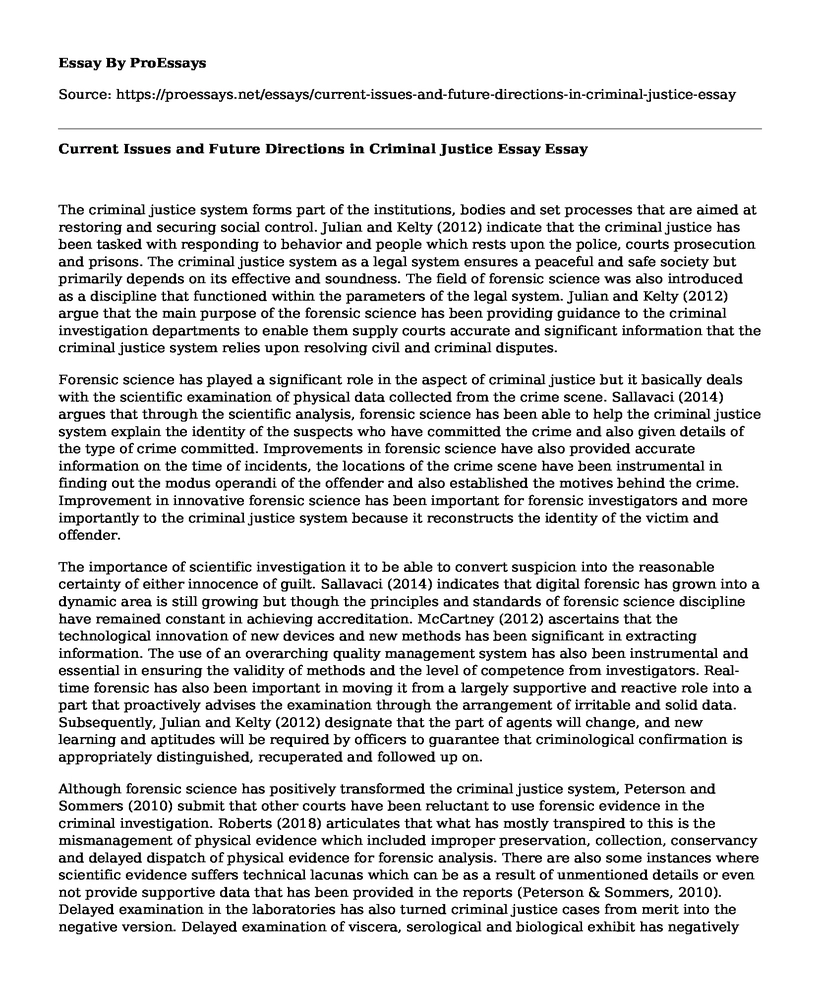The criminal justice system forms part of the institutions, bodies and set processes that are aimed at restoring and securing social control. Julian and Kelty (2012) indicate that the criminal justice has been tasked with responding to behavior and people which rests upon the police, courts prosecution and prisons. The criminal justice system as a legal system ensures a peaceful and safe society but primarily depends on its effective and soundness. The field of forensic science was also introduced as a discipline that functioned within the parameters of the legal system. Julian and Kelty (2012) argue that the main purpose of the forensic science has been providing guidance to the criminal investigation departments to enable them supply courts accurate and significant information that the criminal justice system relies upon resolving civil and criminal disputes.
Forensic science has played a significant role in the aspect of criminal justice but it basically deals with the scientific examination of physical data collected from the crime scene. Sallavaci (2014) argues that through the scientific analysis, forensic science has been able to help the criminal justice system explain the identity of the suspects who have committed the crime and also given details of the type of crime committed. Improvements in forensic science have also provided accurate information on the time of incidents, the locations of the crime scene have been instrumental in finding out the modus operandi of the offender and also established the motives behind the crime. Improvement in innovative forensic science has been important for forensic investigators and more importantly to the criminal justice system because it reconstructs the identity of the victim and offender.
The importance of scientific investigation it to be able to convert suspicion into the reasonable certainty of either innocence of guilt. Sallavaci (2014) indicates that digital forensic has grown into a dynamic area is still growing but though the principles and standards of forensic science discipline have remained constant in achieving accreditation. McCartney (2012) ascertains that the technological innovation of new devices and new methods has been significant in extracting information. The use of an overarching quality management system has also been instrumental and essential in ensuring the validity of methods and the level of competence from investigators. Real-time forensic has also been important in moving it from a largely supportive and reactive role into a part that proactively advises the examination through the arrangement of irritable and solid data. Subsequently, Julian and Kelty (2012) designate that the part of agents will change, and new learning and aptitudes will be required by officers to guarantee that criminological confirmation is appropriately distinguished, recuperated and followed up on.
Although forensic science has positively transformed the criminal justice system, Peterson and Sommers (2010) submit that other courts have been reluctant to use forensic evidence in the criminal investigation. Roberts (2018) articulates that what has mostly transpired to this is the mismanagement of physical evidence which included improper preservation, collection, conservancy and delayed dispatch of physical evidence for forensic analysis. There are also some instances where scientific evidence suffers technical lacunas which can be as a result of unmentioned details or even not provide supportive data that has been provided in the reports (Peterson & Sommers, 2010). Delayed examination in the laboratories has also turned criminal justice cases from merit into the negative version. Delayed examination of viscera, serological and biological exhibit has negatively influenced cases posing question marks on the authenticity of evidence.
Conclusion
Forensic science has become a popular culture for the criminal justice system because of its positive impacts on the identification, classification, reconstruction, corroboration, and identification of physical evidence left at the crime science. Forensic science has been put in place to function within the parameters of the legal system with the purpose of providing guidance to criminal investigation departments for the purpose of supplying courts with accurate information upon which can be relied upon in resolving civil and criminal disputes.
References
Julian, R., & Kelty, S. (January 01, 2012). Forensic Science and Justice: From Crime Scene to Court and Beyond. Current Issues in Criminal Justice Sydney-, 24, 1, 1-6.
McCartney, C. (2012). Forensic identification and criminal justice: Forensic science, justice, And risk. London: Routledge.
Peterson, J. L., & Sommers, I. B. (2010). The role and impact of forensic evidence in the Criminal justice process: Revised final report, 6-10-10. Rockville, MD: NCJRS.
Roberts, P. (2018, July 06). Forensic evidence offers only probabilities, not guarantees that Justice will be served. Retrieved from http://theconversation.com/forensic-evidence-offers-only-probabilities-not-guarantees-that-justice-will-be-served-39230
Sallavaci, O. (2014). The impact of scientific evidence on the criminal trial: The case of DNA Evidence. Milton Park, Abingdon, Oxon; New York: Routledge.
Cite this page
Current Issues and Future Directions in Criminal Justice Essay. (2022, Jul 01). Retrieved from https://proessays.net/essays/current-issues-and-future-directions-in-criminal-justice-essay
If you are the original author of this essay and no longer wish to have it published on the ProEssays website, please click below to request its removal:
- Essay Sample on Jeffrey Dahmer Case
- Research Paper on The Young Lords Party
- Sacco and Vanzetti Case Study
- Essay on ACA: Revolutionizing Healthcare by Closing Insurance Gaps
- Research Paper on 3 Techniques for Collecting Crime Data: Self-Report, Victimization & Law Enforcement
- Psychopathy: Nature vs. Nurture in Criminals - Essay Sample
- Sperm Donor Anonymity in Australia: Legal Challenges and Proposed Frameworks - Free Paper







